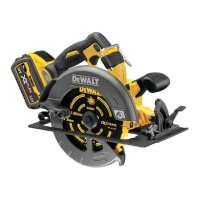14
ENGLISH
b ) Check the operation of the lower guard spring. If the
guard and the spring are not operating properly,
they must be serviced before use. Lower guard may
operate sluggishly due to damaged parts, gummy
deposits, or a build-up ofdebris.
c ) The lower guard may be retracted manually only for
special cuts such as “plunge cuts” and “compound
cuts”. Raise the lower guard by the retracting handle
and as soon as the blade enters the material, the
lower guard must be released. For all other sawing, the
lower guard should operateautomatically.
d ) Always observe that the lower guard is covering the
blade before placing saw down on bench or floor.
An unprotected, coasting blade will cause the saw to
walk backwards, cutting whatever is in its path. Be
aware of the time it takes for the blade to stop after switch
isreleased.
Additional Safety Instructions for
Circular Saws
• Wear ear protectors. Exposure to noise can cause
hearingloss.
• Wear a dust mask. Exposure to dust particles can cause
breathing difficulty and possibleinjury.
• Do not use blades of larger or smaller diameter than
recommended. For the proper blade rating refer to the
technical data. Use only the blades specified in this manual,
complying with EN847-1.
• Use only saw blades that are marked with a speed equal
or higher than the speed marked on thetool.
• Avoid overheating of bladetips.
• Install the dust extraction port onto the saw beforeuse.
• Never use abrasive cut-offwheels.
• Do not use water feedattachments.
• Use clamps or another practical way to secure and
support the workpiece to a stable platform. Holding the
work by hand or against your body leaves it unstable and may
lead to loss ofcontrol.
Residual Risks
In spite of the application of the relevant safety regulations
and the implementation of safety devices, certain residual risks
cannot be avoided. These are:
• Impairment ofhearing.
• Risk of personal injury due to flyingparticles.
• Risk of burns due to accessories becoming hot
duringoperation.
• Risk of personal injury due to prolongeduse.
SAVE THESE INSTRUCTIONS
Chargers
DeWALT chargers require no adjustment and are designed to be
as easy as possible tooperate.
Electrical Safety
The electric motor has been designed for one voltage only.
Always check that the battery pack voltage corresponds to the
voltage on the rating plate. Also make sure that the voltage of
your charger corresponds to that of yourmains.
i
Your DeWALT charger is double insulated in
accordance with EN60335; therefore, no earth wire
isrequired.
If the supply cord is damaged, it must be replaced only by
DeWALT or an authorised serviceorganisation.
Mains Plug Replacement
(U.K.& Ireland Only)
If a new mains plug needs to be fitted:
• Safely dispose of the oldplug.
• Connect the brown lead to the live terminal in theplug.
• Connect the blue lead to the neutralterminal.
WARNING: No connection is to be made to the
earthterminal.
Follow the fitting instructions supplied with good quality plugs.
Recommended fuse: 3A.
Using an Extension Cable
An extension cord should not be used unless absolutely necessary.
Use an approved extension cable suitable for the power input of
your charger (see Technical Data). The minimum conductor size is
1mm
2
; the maximum length is30m.
When using a cable reel, always unwind the cablecompletely.
Important Safety Instructions for All
BatteryChargers
SAVE THESE INSTRUCTIONS: This manual contains important
safety and operating instructions for compatible battery
chargers (refer to TechnicalData).
• Before using charger, read all instructions and cautionary
markings on charger, battery pack, and product using
batterypack.
WARNING: Shock hazard. Do not allow any liquid to get
inside charger. Electric shock mayresult.
WARNING: We recommend the use of a residual current
device with a residual current rating of 30mA orless.
CAUTION: Burn hazard. To reduce the risk of injury,
charge only DeWALT rechargeable batteries. Other types of
batteries may burst, causing personal injury anddamage.
CAUTION: Children should be supervised to ensure that
they do not play with theappliance.
NOTICE: Under certain conditions, with the charger
plugged into the power supply, the exposed charging
contacts inside the charger can be shorted by foreign
material. Foreign materials of a conductive nature such
as, but not limited to, steel wool, aluminum foil or any
buildup of metallic particles should be kept away from
charger cavities. Always unplug the charger from the
power supply when there is no battery pack in the cavity.
Unplug charger before attempting toclean.

